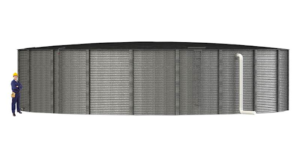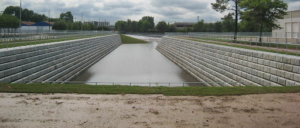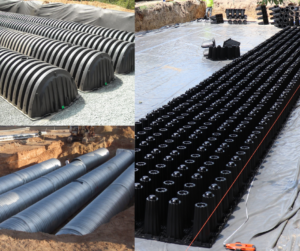Hurricane Harvey Devastates Houston
On August 17th. 2017 Houston was devastated by Hurricane Harvey, one of the worst disasters in the city’s history. The cost was staggering. According to the National Hurricane Center, it caused $125 billion in damages and ranked number 2 ( Katrina was number 1) as the most costly natural disaster in U.S. history. Additionally, 107 souls were lost.
Property damage was widespread, caused mostly by massive flooding in and around the city, forcing 40,000 people out of their homes. By September 1st., a third of the city was underwater, damaging 204,000 homes. Three-fourths of those homes were outside of the 100-year flood plain and most likely not insured for flooding.
This catastrophe made clear to city planners that something had to be done to mitigate the potential for flooding from future storms. Several hundred acres of land were set aside for use as drainage basins and wetland preserves. Moreover, detention rates for new development were reviewed to ascertain whether or not the current rates were adequate or needed to be revised. Ultimately, the decision was made to increase detention requirements.
Houston Implements New Detention Requirements
Implemented on March 31, 2021, the revised detention requirements are as follows:
Single Family – 7500 sq ft or less disturbing less than 65% of the area = 0 detention
Single Family – 7500 sq ft or less disturbing more than 65% of the area = .75 acft/acre (previous rate = .2 acft/ac.)
Commercial – 1 acre or less tract = .75 acft/acre ( previous rate = .2 acft/ac)
Commercial – 1 to 20 acres = .75 -1 acft/ac of impervious
For projects over 20 acres detention is based on Harris County Flood Control District’s Policy and Procedure Criteria Manual.
The detention rates for large (over 1 acre) commercial tracts were already fairly stringent, so those rates didn’t really change. But for single-family dwellings and small commercial tracts, the rates almost quadrupled! This left developers scrambling to figure out where to store all of that water in such a small footprint. At the same time, the city rolled out its Green Stormwater Initiative which includes a tax abatement program that allows for reimbursement of funds spent on green infrastructure for private development over a 10-year period. What this means is that if you use any of the low-impact techniques allowed in that manual, you can be reimbursed for those infrastructure costs. Unfortunately, this does nothing to reduce the detention requirements. If you would like more information on that program visit http://www.houstontx.gov/igd/ Here is a link to the application https://www.houstontx.gov/ecodev/abatements/GSI-Tax-Abatement-Application.pdf
The Challenge To Be Compliant
If you take a look at the application for reimbursement you’ll soon realise just how daunting a task this is. The cost to engage an engineer to apply may or may not offset the saving on reimbursement. This holds especially true for smaller projects of tracts 1 acre or less, whether commercial or residential.
Regardless of the system used, traditional or green infrastructure, detention will still be required. So now we come to the real problem. Where are we going to store all of this water on such a small site? But just how much water are we talking about? As an example let’s take a ½ acre residential lot with buildings and paving on the entire property. Prior to 2021 that ½ acre would require .2 acre-feet per acre which equates to 32,585 gallons of storage.
For reference, that is about the size of a large pool. A really large pool roughly 20 x 40 ft x 5 ft. deep. A lot of storage to be sure, but manageable. Now if we look at the current requirements we’ll need about 122,000 gallons of storage. The size of that pool would be 35 x 100 x 5 ft. deep. Of course, that wouldn’t be a pool but a dry detention pond with vertical walls. Not a realistic option. So what options do we have?
Unfortunately, there is no workaround. And there are only a few options that make any sense. Above-ground storage, ground-level storage, and underground storage.
Above Ground Storage

Using this 100,000 gallon tank, we still need another 20,000 gallons of storage.
Above-ground storage– Using rain barrels or cisterns may be a viable option if you have enough space to store such a large tank.
For comparison’s sake let’s look again at the required storage volume of 122,000 gallons. A tank of that size would be 42 ft. in diameter and 9 ½ ft. tall. Where are we going to put this monster?
At this point, a 35 x 100 x 5 ft. a detention pond is starting to look like a better option.
In Ground Storage

Do you want one of these on your property?
In-ground storage is a vertical wall detention pond that loosely resembles a pool.
These can be built using either poured concrete, block, gabions, or several vegetated options.
These systems are very costly and dependent on available space.
But realistically, it’s highly unlikely that our ½ acre property has space for such a system. Not to mention how ridiculous this would look on a residential property.
Underground Storage

Examples of Under Ground Storage
Underground storage has been around for quite some time. But as a homeowner or even a home builder, you’ve most likely never heard of (nor had the need for) underground detention.There are several different systems available from pipe, to arched chamber, as well as modular systems.
If we look back at our ½ acre lot we can see that we still need 35 x 100 x 5 ft. of storage. But now we take that storage under the driveway or grassy areas. Underground detention is not allowed under the house. As you can see, underground is the most sensible option in the majority of situations.
And if using a modular system, you don’t need a single hole. Modular systems can be snaked around encumbrances or located throughout the property as mini-detention sites.
Final Thoughts
Which system to use is dependent on a multitude of factors, the most important being which one(s) will actually fit given space constraints. But ultimately it comes down to the owner’s cost tolerance, as all of these systems are fairly expensive compared to a simple detention pond with standard 3/1 slopes (3 ft. horizontal to 1 ft. vertical slope).
Being well-versed on upfront as well as maintenance costs, we can help by breaking down these costs for you on your project. We always look at total install costs since that is really the only way to compare apples to apples.
Let us know how we can help with your next project.
